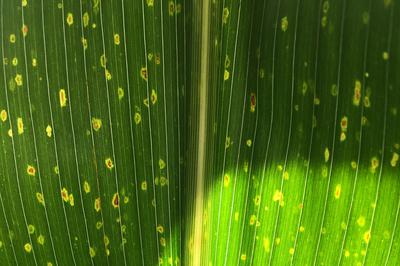Eyespot of Maize
Kabatiella zeae
Fungus
In a Nutshell
- Water-soaked spots on lower leaves.
- Lesions develop into 'eyespots' - tan center, darker margin.
- Coalescing to wilted patches.
Can also be found in
Symptoms
Minute, water-soaked, round lesions appear on lower leaves. The lesions enlarge and develop into "eyespots", with a tan center, a darker brown margin and a larger yellow “halo”. They later coalesce to form patches of chlorotic or necrotic tissues. Lesions are most common on older leaves, but can also be observed on sheaths and husks.
Recommendations

Organic Control
Sorry, we don't know of any alternative treatment against Kabatiella zeae. Please get in touch with us in case you know of something that might help to fight this disease. Looking forward to hearing from you.

Chemical Control
Always consider an integrated approach with preventive measures together with biological treatments if available. Carefully weight the pros and cons of a fungicide treatment in terms of yield potential, the value of the crop, and the cost of the fungicide. Fungicide treatments include mancozeb, propiconazole, and chlorothalonil. Seed treatments with these compounds can also be considered.
What caused it?
The fungus survives in corn residue on the soil and may also be found on seeds. In the spring, it starts to produce spores that are spread by wind or rain splashes to new crops. Secondary spread is by wind and water splashing of spores from one plant to another. Leaf wetness, cool temperatures, frequent rainfalls or dew favor the outbreak of the disease. Hot and dry weather, on the other hand, will help to slow its progression. Monocultures and reduced tillage practices are also advantageous for the development of the fungus. If the fungus spreads to the upper parts of the plant during flowering or corn maturity stages can reduce plant productivity and yields.
Preventive Measures
- Plant resistant or tolerant varieties if available locally.
- Plow deep and bury plant debris after harvest.
- Rotate with non-susceptible crops for a period of 2 years or more.



